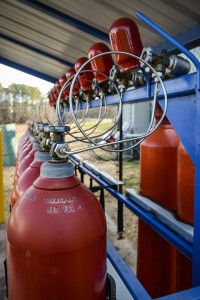By Cindy Carroll
What’s down the road for U.S. drivers?
J. Ronald Bailey’s answer is all about the need for energy-efficient vehicles. “Someday it will be a fuel cell car that has a reversible fuel cell built in, so that it becomes its own fueling station. You have stored hydrogen and oxygen on board the vehicle; you use it when you drive. Hydrogen goes into the fuel cell, mixes with oxygen, and the car runs and produces pure water. You save the water. When the car is stationary, you park it over a wireless charging station connected to the electrical grid and reverse the fuel cell so it can convert the water right back into hydrogen and oxygen to refuel the car,” he explains. Bailey, Guerry Professor of Engineering, has spent the last six years researching alternative fuels as the director of the Center for Energy, Transportation and the Environment (CETE) at the University of Tennessee at Chattanooga.

Applied research at the center has allowed him to build relationships with many community partners, including Volkswagen, Tennessee Valley Authority, Electric Power Board, EV America, the Federal Transit Administration (FTA) and the Chattanooga Area Transportation Authority (CARTA). CETE runs solely on external funding and engages engineering students in research, mostly during their capstone design projects. FTA asked Bailey to crack this nut: Find a way to extend the range for electric buses and keep them on the road longer. CARTA’s fleet of electric buses has carried 1 million passengers annually for 20 years, operating in a loop around downtown Chattanooga. Conventional batteries are used and swapped as needed during the day. Bailey led UTC researchers in the testing of new lithium iron phosphate batteries that increased the range for the buses to more than 100 miles, eliminating the need for battery swapping.
For larger buses operating outside the relatively flat downtown route, UTC took the lead in the first North American demonstration of an inductive wireless charging procedure. Buses park on a buried charging plate, automatically drop a coil mounted on the bottom of the bus and receive a charge while loading and unloading passengers. This technique virtually eliminates all range limitations for electric buses if the charge time is long enough to provide the energy required to reach the next charging station. The FTA subsequently funded four new projects to deploy the wireless charging technology for transit operations across the country. As the technology matures, a standard for wireless charging is needed so that all buses and cars can access any charger. Bailey is working with a task force within the Society of Automotive Engineers to address the issue.
Thanks to TVA, UTC has acquired the Advanced Vehicle Test Facility located near campus. Amid its 43 acres sits the newly transformed energy-plus building. A Clean Tennessee Energy Grant from the Tennessee Department of Environment and Conservation has funded geothermal piping and a highly efficient ground source heat pump to replace an existing air source HVAC system. Air ducts are better insulated, WiFi controls thermostats, and the solar photovoltaic system now allows photovoltaic cells to directly convert sunlight into electricity on the sloped roof of the facility.
The property also includes a one-mile asphalt track, the perfect place to test the performance of any highway vehicle. Under an FTA contract, Embedded Power Controls recently tested a fuel cell bus there that was built by EV America, a Ringgold, Ga., company. This bus was delivered to the University of Alabama at Birmingham for use as a campus shuttle. “It runs on hydrogen. The only thing coming out of the fuel cell is water, so you’re not going to have any diesel fumes on their campus, and it’s virtually silent. It’s a nice project,” Bailey says. Bailey has worked diligently in his UTC career to create positive change for both drivers and the environment. While most of us flip a switch to turn on a light and never give another thought about how the energy comes into a room, Bailey and engineers like him are always cognizant of what it takes to be truly innovative.
“As we see more and more people in the world using more and more energy, it becomes scarcer, more expensive, and the environmental consequences of burning carbon based fossil fuel becomes more apparent,” he says. “One of the challenges is to be more efficient. We seldom get more than 20 percent of true chemical energy out of anything. The automobile, after being around for a hundred years, is about 20 percent efficient. That’s got to change.”



